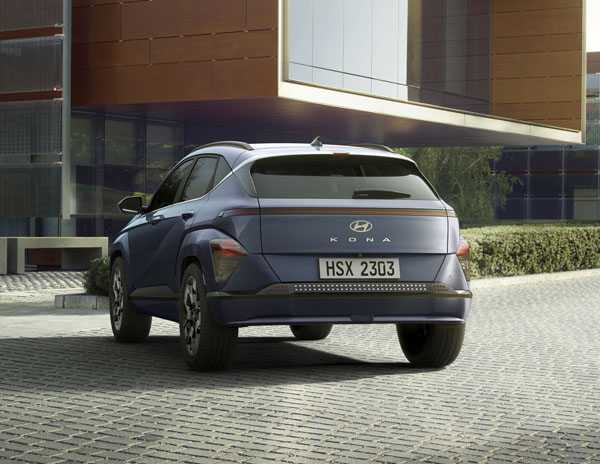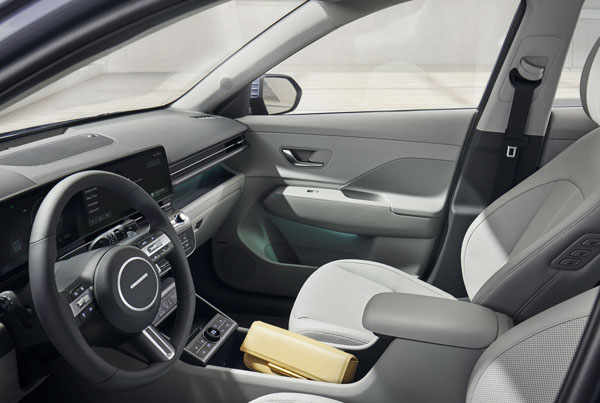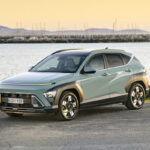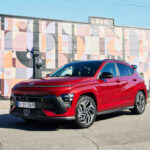
Hyundai’s new Kona has been designed as an EV first and foremost, rather than the
other way around.
The result is a futuristic, EV-centric exterior that accentuates the SUV’s size to make a
rugged and dynamic impression.
Second-generation Kona offers one of the most comprehensive product packages in its
market segment, including the widest range of powertrains.
Customers can choose from EV (standard or long range), hybrid electric (HEV) and
internal combustion engine (ICE) variants as well as sporty N Line versions of each.
Upgrades include dual 12.3-inch panoramic display screens, a Digital Key 2 Touch, full
Over-the-Air (OTA) updates and Connected Car Navigation Cockpit (ccNC).
Kona Electric delivers class-leading all-electric range, with an estimated 490km
(WLTP).
It also comes with EV-specific design elements, including frunk storage, active air flaps,
interior and exterior Vehicle-to-Load (V2L) outlets, Head-up Display (HUD), i-PEDAL
driving mode, Smart Regenerative System, electronic-Active Sound Design (e-ASD)
and an Eco Package.
Based on the previous EV variant, it is 175mm longer, 25mm wider and 20mm taller,
with a 60mm longer wheelbase. It’s designed to provide a larger interior ‘living space’ to
accommodate a wider range of lifestyles.

The driver-centric front row is accentuated by a floating horizontal C-Pad with
integrated dual 12.3-inch panoramic display screens.
As part of the new layout the shift-by-wire gear selector has been relocated from the
centre console to behind the steering wheel, which allows more storage in the open
console area.
The first row’s relaxation comfort seat option is optimised for ‘weightless’ body pressure
distribution to help alleviate fatigue after driving.
The Curveless Bench Seat in the second row maximises ‘habitability’ and easy
maintenance, with a two-stage latch for reclining.
The fully foldable second-row seat and rear compartment provide up to 466 litres of
cargo space, with a smart power tailgate to enhance access.
In addition to the Pixelated Seamless Horizon Lamp and Pixel graphics, battery
preconditioning ensures secure charging and range performance in winter.
A new charging port door light ensures visibility at night.
HUD displays the most relevant information for drivers as a 12.0-inch projection on the
windshield.

e-ASD creates a virtual sound that makes EVs more engaging for the driver.
An optimum sound is added to the cabin, considering variables, such as driving speed,
torque, state of the motor and acceleration.
Drivers can control the volume and customise the sound inside the cabin.
With a bi-directional onboard charge, the Vehicle-to-Load (V2L) function can power any
device or charge electrical equipment, with both interior and exterior outlets for
convenience.
Inside, devices can be plugged into a standard outlet on the rear centre console when
the EV is powered on.
Outside, devices and home appliances can be plugged in using a V2L adapter to use
battery power when the car is parked.
A new i-PEDAL allows drivers to accelerate, decelerate and stop using only the
accelerator pedal.
The Smart Regenerative System automatically adjusts the amount of regenerative
braking based on information from forward traffic flow.
All-new Kona takes connectivity to the next level with continuous Over-the-Air (OTA)
software updates.
The car can be locked, unlocked and started through the Digital Key 2 Touch, using
near-field communication (NFC) on smart phones or smart watches, which assures a
high level of security.
Inside, dual 12.3-inch panoramic display screens are integrated into the audio-video
navigation (AVN) system to give drivers an immersive digital experience.
New Kona will be the first Hyundai model to apply the new Connected Car Navigation
Cockpit (ccNC), which provides advanced graphics and perfect unity among the vehicle
displays.
When parking, Surround View Monitor (SVM) displays the vehicle from various
viewpoints for safe and easy parking.
Forward Collision-avoidance Assist 2.0 (FCA 2.0) provides evasive steering, junction
crossing, lane change ongoing and lane change side lane.
It also has Highway Driving Assist 2 (HDA 2), which helps drivers maintain a safe
distance from the vehicle ahead and assists by overtaking slower vehicles in front.











